The European Union has prepared a bill according to which, as early as July, Ukraine can begin to profit from frozen Russian sovereign assets.
This was reported by Bloomberg.
Frozen assets of the Russian Federation
The legislation, which requires the support of all EU member states, provides for the introduction of a tax on profits received from Russian assets. The money will be used to finance arms supplies to Ukraine and the development of the Ukrainian defense industry, the draft documents say.
Now watching
About 260 billion euros ($282 billion) of Russian central bank assets, mostly securities and cash, have been frozen by the Group of Seven countries, the EU and Australia. More than two thirds of these assets are blocked in the EU.
The White House is insisting that G7 allies fully seize frozen assets. But several European countries, including Germany and France, as well as the European Central Bank are against such a move.
Financing aid to Ukraine
Ukraine is now experiencing a critical shortage of artillery ammunition, and about $60 billion in aid is still blocked in the US Congress. Therefore, the issue of financing for Ukraine is especially acute.
The EU proposes that a share of income received from February 15th will be transferred to the EU every two years until sanctions are lifted. Initially, the funds will go to the European Peace Fund, a mechanism to reimburse the cost of weapons supplied to Kyiv, and to the EU budget fund for Ukraine.
Part of the profits will remain in central depositories where reserves are kept to cover the costs of asset management and cope with any risks, including possible retaliatory measures from the Russian Federation.
Related expenses and corporation tax will also be deducted from income before they are transferred. According to preliminary estimates, this will leave about 3 billion euros of net profit per year.
A significant portion of the funds were frozen through the Belgian clearing house Euroclear, and last year they brought in about 4.4 billion euros in profit.

